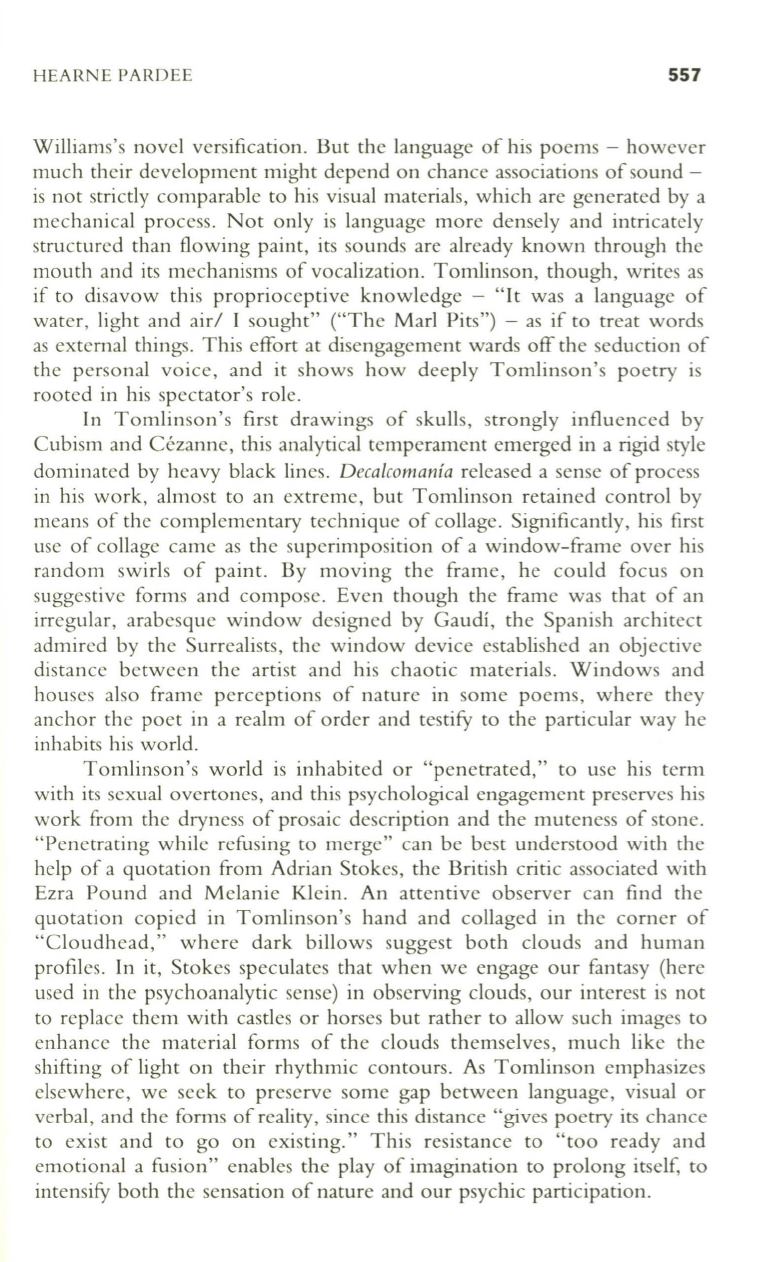
HEARNE PARDEE
557
Williams's novel versification. But the language of his poems - however
much their development might depend on chance associations of sound -
is not strictly comparable to his visual materials, which are generated by a
mechanical process. Not only is language more densely and intricately
structured than flowing paint, its sounds are already known through the
mouth and its mechanisms of vocalization. Tomlinson, though, writes as
if to disavow this proprioceptive knowledge - "It was a language of
water, light and air/ I sought" ("The Marl Pits") - as if to treat words
as external things. This effort at disengagement wards off the seduction of
the personal voice, and it shows how deeply Tomlinson's poetry is
rooted in his spectator's role .
In Tomlinson's first drawings of skulls, strongly influenced by
Cubism and Cezanne, this analytical temperament emerged in a rigid style
dominated by heavy black lines.
Decalcomania
released a sense of process
in his work, almost to an extreme, but Tomlinson retained control by
means of the complementary technique of collage. Significantly, his first
use of collage came as the superimposition of a window-frame over his
random swirls of paint. By moving the frame, he could focus on
suggestive forms and compose. Even though the frame was that of an
irregular, arabesque window designed by Gaudi , the Spanish architect
admired by the Surrealists, the window device established an objective
distance between the artist and his chaotic materials. Windows and
houses also frame perceptions of nature in some poems, where they
anchor the poet in a realm of order and testify to the particular way he
inhabits his world.
Tomlinson's world is inhabited or "penetrated," to use his term
with its sexual overtones, and this psychological engagement preserves his
work from the dryness of prosaic description and the muteness of stone.
"Penetrating while refusing to merge" can be best understood with the
help of a quotation from Adrian Stokes, the British critic associated with
Ezra Pound and Melanie Klein. An attentive observer can find the
quotation copied in Tomlinson's hand and collaged in the corner of
"Cloudhead," where dark billows suggest both clouds and human
profiles. In it, Stokes speculates that when we engage our fantasy (here
used in the psychoanalytic sense) in observing clouds, our interest is not
to replace them with castles or horses but rather to allow such images to
enhance the material forms of the clouds themselves, much like the
shifting of light on their rhythmic contours. As Tomlinson emphasizes
elsewhere, we seek to preserve some gap between language, visual or
verbal, and the forms of reality, since this distance "gives poetry its chance
to exist and to go on existing." This resistance to "too ready and
emotional a fusion" enables the play of imagination to prolong itself,
to
intensify both the sensation of nature and our psychic participation.


